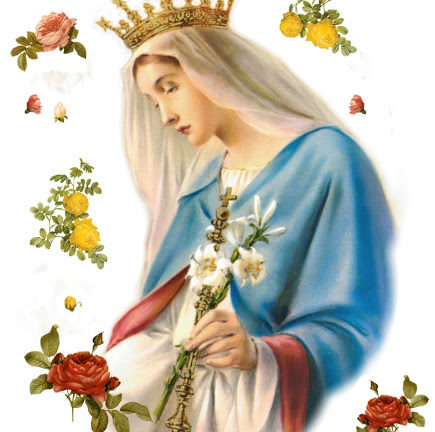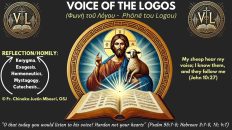The third title of our Lady in the Litany of Loreto attests to her virginity; in fact, it refers to her as the “holy Virgin of virgins.” This is quite similar to one of her titles found towards the end part of her Litany – “Queen of virgins”. In addressing our Lady as the “Holy Virgin of virgins” and the “Queen of virgins”, we must first understand clearly and clarify the misconceptions and objections surrounding the doctrine of her perpetual virginity. How could the Permanent Virginity of Mary be understood in the light of Sacred Scripture and in the writings of the Church fathers? Did Mary lose her virginity with the birth of her Son? Did St. Joseph have sexual relations with her after the birth of Christ?
The Church has always professed that Mary was a virgin “antepartum, in partu, et postpartum,” i.e., before birth, during birth, and after the birth of Christ, as far back as the second century A.D, clearly seen in the writings of many of the early Church Fathers – St. Augustine, Pope St. Leo the Great, St. Peter Chrysologus, St. Gregory Nyssa, St. Gregory Nazianzus, etc. Scripture tells us that Mary conceived Jesus in her womb “by the power of the Holy Spirit” without loss of her virginity. She remained a virgin in giving birth to Jesus; His miraculous birth did not diminish her virginal integrity but sanctified it (cf. Vatican II, Lumen Gentium, no. 57). Following the birth of Jesus, Mary remained a virgin for the rest of her earthly life, until she was taken body and soul into heaven, where she reigns as Queen (cf. Lumen Gentium, no. 59). The Catechism of the Catholic Church, quoting St. Augustine, says: “Mary remained a virgin in conceiving her Son, a virgin in giving birth to Him, a virgin in carrying Him, a virgin in nursing Him at her breast, always a virgin” (CCC #510).
Mary’s virginity “antepartum” (prior to the birth of Christ) is apparent from the Gospels of Matthew and Luke, where she is clearly identified as “a virgin” (cf. Luke 1:26-27, Matthew 1:18). Moreover, when Archangel Gabriel announced to Mary that she would be the mother of the Messiah, she responded, “How can this be since I do not know a man?” indicating her virginity. St. Matthew describes the virginal conception as a fulfilment of the prophecy of Isaiah 7:14: “The virgin shall be with child, and give birth to a son, and they shall call him Emmanuel.”
The Church’s teaching on Mary’s virginity “in partu” (during the birth of Christ) and the “miraculous birth” indicates that she was not violated physically. This is important because the virginity of Mary “in partu” ‘protects’ the miraculous nature of birth, in turn, the miraculous birth points to the integrity that goes beyond the mere absence of sexual relations, and which further is a sign of Mary’s interior virginity. There are several Old Testament imageries that support the virginity in partu. St. Ambrose refers to Mary as the east gate of Ezekiel; it says: “Then, He brought me back to the outer gate of the sanctuary which faces toward the EAST, but it was shut. And the Lord said to me: ‘This gate shall be shut; it shall not be opened, and no man shall enter by it, because the Lord God of Israel has entered by it; therefore it shall be shut’” (Ezekiel 44:1-2). Also, Isaiah 66:7 refers to the delivery of a male child born without labour pains. Lastly, there is a reference in the Song of Songs (4:12) to the bride being an enclosed garden and a sealed fountain. It is pertinent to note that Mary wrapped the Child in swaddling clothes (cf. Lk. 2:7) and laid Him in a manger, which indicates the absence of the usual pains and infirmities of childbirth.
Mary’s Virginity post-partum (after the birth of Christ) is apparently the most difficult to understand and accept ranging from confused Catholics and non-Catholics alike, as such there have been persistent arguments in this regard. The most persistent objections to Mary’s virginity post-partum is, first, the frequent scriptural references to Jesus’ “brothers” and sisters (cf. Matthew 13:55, Mark 3:31-35, Luke 8:20, John 2:12 and 7:3-5, Acts 1:14, Galatians 1:19 1Corinthians 9:5). Nevertheless, the Church clarifies (based on Scripture) that the Greek word “brother” in English (i.e., adelphos) can be used to designate not only a blood brother but can also denote varying and even remote degrees of relationship. “Adelphos” (i.e., “brother”), standing alone, is thus inconclusive on the point. Further examination of the biblical texts alone reveals that these purported “brothers” were not the children of Mary. Indeed, nowhere in Scripture is the Blessed Virgin Mary ever explicitly identified as the earthly mother of anyone other than Jesus. There is an additional argument that the “brothers” appear to be older than Jesus, and there is ample scriptural support for the proposition that Mary had no children before Jesus (e.g., Matthew 1:18-25, Luke 1:26-38 and 2:7). The same goes for “sister” (in Greek adelphe) and the plural form “brothers” (adelphoi). The Old Testament (written originally in Hebrew) also shows that the word “brother” has a wide semantic range of meaning and could refer to any male relative from different parents, just as we still apply in our respective cultures in Nigeria… etc. In the Old Testament, Lot, for example, is called Abraham’s “brother” (Gen. 14:14), even though, being the son of Haran (the brother of Abraham) (Gen. 11:26–28), Lot was actually Abraham’s nephew. Similarly, Jacob is called the “brother” of his uncle Laban (Gen. 29:15) etc. This is so because neither Hebrew nor Aramaic had a special word meaning “cousin,” etc. Hence, speakers of those languages could use either the word “brother” or a circumlocution, such as “the son of my uncle.” However, circumlocutions are clumsy, so the Jews often used “brother” or “sister” (where it applies). In the same vein, the writers of the New Testament imported the Hebraic/Aramaic sentiment of the use of “brothers” and “sisters” when they wrote in Greek. In other words, they did the same thing the translators of the Greek Septuagint did. That is, translating the Old Testament from Hebrew to Greek, the Jewish translators grouped the idea of cousin, nephew, niece, etc. to mean brother (ἀδελφός – adelphos) as indicated in the Hebrew Bible, inasmuch as the Greek language has a separate word for cousin (anepsios). Put differently, the translators of the Greek Septuagint used adelphos, even for true cousins. It is interesting to note that these so-called “brothers” (adelphos) of Jesus – James, Joseph, Simon, and Jude are pictured at the crucifixion scene (in Matthew 27:56) as the children of other women. This becomes clearer when we cross-reference it with John 19:25, which says: “at the cross were present the mother (Mary) of Jesus, and her sister, Mary (the wife of Clopas), and Mary of Magdala”. That is, 3 Marys at the foot of the cross! Why is this significant? Mary the wife of Clopas is known as the mother of James and Joseph (or Joset), and John says she is the sister of Mary the mother of Jesus (in the real sense, sister-in-law). Therefore, when we combine all these, it becomes obvious that these “brothers” are certainly the cousins of Jesus. It is interesting to note that none of these so-called brothers and sisters of Jesus was referred to as the child/children of Mary or Joseph in the bible; Mary and Joseph at different times were referred to as the parents of Jesus alone. When the Holy family returned from Egypt, nothing was mentioned of Jesus’ brothers; instead, we hear of Joseph, Mary, and the Child. (Mt. 2:19-20). Likewise, when the parents of Jesus searched for Jesus for three days, nothing was said of his brothers. At this time, he was already twelve years. (cf. Lk. 2:41-52). Before his death, in John 19:26, Jesus gives his mother to the Apostle John. If Jesus had blood brothers, then, it would violate Jewish customs that the next son in line would have to care for the mother. Being the only son, Jesus made sure that Mary was taken care of by a non-blood brother: the apostle John (brother of James). Therefore, this proves that Matthew 13:55-56 in no way demonstrates that Mary had other children.
Another objection is the reference to Christ as being a “firstborn” son, which indicates that they could be a second, third and so on. However, St. Jerome convincingly responds that every “only child” is a firstborn child, and he further explains that the Jewish practice was to offer sacrifice upon the birth of a “firstborn,” without the necessity of waiting for subsequent children to be born. Scripture scholars recognize that prototokos (“firstborn”) is only a legal status and only means no prior child, and it is sometimes the equivalent of monogenes (“only-born”).
Another objection, which for me, is the weakest of all, is the way the antagonists of the perpetual virginity of Mary distort the beautiful texts from the Sacred Scriptures to defend their position. Matthew says in his Gospel: “And he did not know her until he gave birth to his son” (Matthew 1: 22-25). Of the term “until”, these antagonists claim that Mary lost her virginity after giving birth to Jesus. But sincerely we all know that this was not the case, because when we say that an airline has not had accidents until today, it does not mean that tomorrow it will have an accident, but the term is used to designate only what happened. We also know that Matthew was only interested in showing in that passage that Jesus was born of a virgin, without contact from Joseph. Like the example of the airline presented above, often both in Hebrew and in the Greek of the Holy Scriptures, the terms “until” (“heus” and “heus ous”) occur to designate only what happened in the past, with no indication of what would happen in the future, but with the intention of simply changing focus. We can exemplify types of phrases that, without wanting to indicate discontinuity of action, apply the term “until”: “The Jewish authorities rejected Christ as Messiah until he was crucified.” (Which does not mean they later accepted him); “Elizabeth and Zachariah loved each other very much until they conceived John the Baptist” (which does not mean they later stopped loving each other); In these examples, the term “until” is only being used to change focus.
Likewise, we can find related passages in the Bible where the term “until” is not used to designate discontinuity of action: John 9:18 – “They still did not believe that he had been blind and had received his sight until they sent for the man’s parents.” – Here, the author continues, showing the unbelief of the Pharisees, which shows that the term is not even indicating discontinuity. In 1 Corinthians 15:25, we read: “For he must reign until he puts all enemies under his feet.” – Here, this passage just wanted to send a message, but if we interpret it literally, it tells us that the kingdom of Christ has ended. However, it is said in the Bible that the kingdom of Christ “will never end” (cf. Luke 1:33). Also, Matthew 28:20 reads: “Behold, I am with you always, until the end of the world.” – If we take the term “until” to mean discontinuity, then does it mean that Jesus would abandon us after the end of the world? Obviously not. Thus, the biblical passages mentioned above indicate that the “until” does not indicate discontinuity. Therefore, the phrase “And he didn’t know her until he gave birth to his son”, shows how Matthew reinforces the idea that the birth of Jesus was not due to the sexual union of Joseph and Mary, but by the power of the Holy Spirit, and even after she put to bed, Joseph still did not have carnal knowledge of her.
Another major objection is based on an inability to reconcile “post-partum” virginity with Mary and Joseph’s having a “true marriage.” Some have argued that since Catholics believe that Joseph and Mary had no sexual relations after the birth of Christ, then there was no true marriage as a result of the absence of consummation. However, that would be a misleading position because marriage involves unconditional self-giving that may be physically expressed, although not necessarily, because one may possess a right without exercising it. Consent, not consummation, is “the indispensable element that ‘makes the marriage’” (cf. Catechism, #1626). John Paul II makes it clear in his apostolic letter “Guardian of the Redeemer” (#7) that Joseph and Mary had a true marriage. A good way of understanding this kind of chaste and virgin-marriage is returning to the Bible, in Luke 1:34, the archangel Gabriel tells Mary that she is to be the Mother of the Messiah, and Mary asks, “How can this be since I know not a man?” We already found out earlier in Luke 1:27 that Mary and Joseph were betrothed to one another. So why would Mary, who already knew the facts of life at that time ask such a question if she and Joseph were already married, but not living together yet? This is most probably a vow of virginity which she did (as explained by the Church fathers). We learn from the Bible that a vow of virginity taken as a youth can even be enforced during marriage if the husband doesn’t object (cf. Numbers 30:2-7).
Having said these, it is appropriate to consider a saying from St. Jerome, one of the early fathers of the Church. He says: “You say that Mary did not continue a virgin: I claim still more that Joseph himself, on account of Mary was a virgin, so that from a virgin wedlock a virgin son was born. {Perpetual Virginity of Blessed Mary, 21 (A.D. 383)}.
Therefore, in remaining perpetually a virgin, Mary becomes a model for all those who follow the path of virginity; little wonder she is fittingly called “Holy Virgin of virgins” and “Queen of virgins.” In conclusion, we must note that Mary’s Perpetual Virginity is not only an exhortation to imitate Mary’s charity, discipleship, fidelity, continence, etc. (cf. Lumen Gentium, nos. 63-64), but also highlights the uniqueness of the Incarnation, of God taking the initiative to recreate the human race through His Son, the New Adam, who was born of the Virgin Mary (the New Eve).
Holy Virgin of virgins, pray for us; Queen of Virgins, pray for us
Shalom!
© Fr. Chinaka Justin Mbaeri, OSJ
Paroquia Nossa Senhora de Fatima, Vila Sabrina, São Paulo, Brazil
nozickcjoe@gmail.com / fadacjay@gmail.com
___________________________________
PS: Have you prayed your Rosary today?



Our mother Mary, queen of virgins pray for us.
Oh Mary, Queen of virgins, pray for us now and always, Amen.
Holy Virgin of virgins, pray for us; Queen of Virgins, pray for us
Queen of Virgins pray for your children.
This quite revealing and a joy to read, again thank you for sharing this knowledge.
Holy virgin of virgins, pray for us
Oh mother Mary queen of virgins, pray for us.
Queen of virgins!!!
Pray for us
Holy Virgin of virgins, pray for us; Queen of Virgins, pray for us
Mary virgin of virgins, pray for us Amen.
Queen of virgins, pray for us
Very well explained and equally well understood.
Thank you so much Padre,will send this to my nephew who has ideas that JESUS had brothers
Holy Virgin of Virgins, Pray for us and grant all our prayers and good heart desires Amen
Yes Mary was a virgin,so that from the virgin wedlock a virgin son was born.
Mother of God pray for us sinners now and at the hour of our dead
St Mafy Queen of virgin pray for us
Queen of virgins, pray for us
Queen of the most holy rosary, pray for us.Amen
Our Lady Queen of Virgin, pray for us
Holy Virgin of Virgins pray for us and Queen of Virgins, pray for us. Amen
Virgin of virgins pray for us, aveee.
Our Blessed Virgin Mary, Mother of our Saviour. Pray for us Amen
Your reflection on Mary’s perpetual virginity has taught me in some way that chastity exist even in marriage. Thank you and God bless you Padre
Mary Queen of Virgin pray for us
Holy Virgin of Virgins! Queen of Virgins Pray for us
Thank you so very much padre, For all this details explainons for us always. God continue to strengthen you more in his vine yard.
Mother Mary, pray for us
Our lady queen of virgins, pray for us
Our Mother of Perpetual Help, Pray for us
Holy Virgin of virgins, pray for us; Queen of Virgins, pray for us
Holy Virgin of Virgins pray for us Amen
Queen of Virgin… Pray for us
Holy Virgin of Virgins…..pray for us.
Amen
Holy Virgin of virgins! Pray for us. Amen
Mother pray for all virgins and preserve their purity. Amen.
Holy Virgin of Virgins, pray for us.
Thank you Padre for your explanations.
Holy virgin of virgins, pray for us.
Holy Virgin of virgins Pray for us, Queen of virgins Pray for us
Our Lady Virgin of Virgins pray for us
Holy Virgin of virgins…. Pray for us
Queen of Virgins….. Pray for us.
Amen